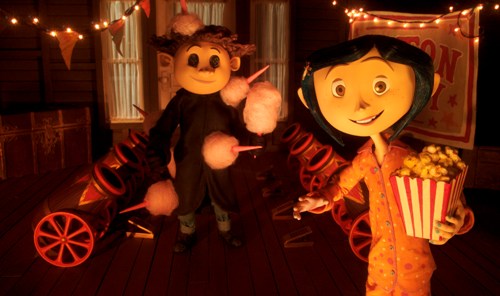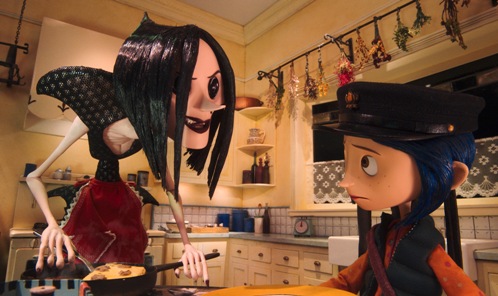 Whether you go through the looking glass, down the rabbit hole, over the rainbow, or into the labyrinth, you are bound to encounter wonders beyond your imagination, sights and sounds that impress the senses and embed themselves upon the brain with all the enchantment of a beautiful dream, but somewhere in our minds we know that dreams are not real and that if something seems too good to be true, inevitably it is. This is the simple lesson of CORALINE, the amazing new stop-motion film from Henry Selick (director of Tim Burton’s THE NIGHTMARE BEFORE CHRISTMAS), but like all truisms, the very simplicity lends power to the moral; the old familiarity makes us feel as if we are re-learning something that was known and then forgotten, and in doing so we regain an important part of ourselves that was lost: a little piece of childhood imagination, a renewal of our Sense of Wonder. This is especially true when the lesson is painted in vivid hues that spark the imagination, that take the abstract concept and bring it to life. This is the triumph of CORALINE.
Whether you go through the looking glass, down the rabbit hole, over the rainbow, or into the labyrinth, you are bound to encounter wonders beyond your imagination, sights and sounds that impress the senses and embed themselves upon the brain with all the enchantment of a beautiful dream, but somewhere in our minds we know that dreams are not real and that if something seems too good to be true, inevitably it is. This is the simple lesson of CORALINE, the amazing new stop-motion film from Henry Selick (director of Tim Burton’s THE NIGHTMARE BEFORE CHRISTMAS), but like all truisms, the very simplicity lends power to the moral; the old familiarity makes us feel as if we are re-learning something that was known and then forgotten, and in doing so we regain an important part of ourselves that was lost: a little piece of childhood imagination, a renewal of our Sense of Wonder. This is especially true when the lesson is painted in vivid hues that spark the imagination, that take the abstract concept and bring it to life. This is the triumph of CORALINE.
The opening titles perfectly set the tone – both fanciful and grim – as spidery metallic fingers perform surgery on an old doll, retrofitting its appearance for what we will eventually realize is a new victm. Coraline is a bored young girl who has just moved into a new home far from her old city life. Mother and Father are too busy writing a catalogue to pay much attention; fortunately – or so it seems at first – Coraline discovers a small doorway to a parallel world, where everything seems the same, only better. The “other” Mother and Father cook tasty meals instead of boring health food, and the lavish their daughter with love and attention. However, there are ominous hints for those with eyes willing to see – such as the fact that all the alternate characters have buttons instead of eyes. Like Pan’s Labyrinth, this alternate reality offers no real escape; gradually, this dreamworld of bliss and childish fun will transform into a nightmare world of horror, and Coraline will have to take a big step toward adulthood if she hopes to escape.
Typically, modern entertainment aimed at families and children tends to be told from a romanticized adult perspective that glosses over the emotional traumas of childhood. CORALINE, like the best fairy tales, dives right into the deep end of the dark pool, drowning its audience in uncanny images guaranteed to send a shiver down the spine: a cat crunching on a cute mouse (that turns out to be a rat in disguise) or the “Other Mother’s” eyes being clawed from her face. The sense of childish vulnerability in the face of unbridled malevolence lends CORALINE all the shuddery effectiveness of a horror movie; in fact, it would be no exaggeration to say that this is, in fact, as good as or better than any horror film we have seen so far this year.
The little joke embedded in the storyline is that the traditional figure of the Wicked Step-Mother is blurred and doubled. Coraline’s real Mother conforms to the stereotype, neglecting the girl, refusing to purchase finery for her, smf speaking in harsh reprimands that ignore the child’s need for affection. The Other Mother at first seems to be the “Good Mother,” the one who will supply all of Coraline’s childish needs. But this Goodness is really an illusion – or rather a mistake in perception. Like all selfish children, Coraline defines Good in terms of what is good for her, ignoring that there is a price to pay and that the well being of others must also be taken into account.

This first becomes apparent in the figure of Corline’s annoying neighbor, Wybie, who in the Alternate World has been permanently silenced by the Other Mother. Coraline’s concern is at best fleeting – she hopes the process didn’t hurt – but by the end of the tale she will have reached a point where, even when her own safety seems assured, she will put herself at risk to aid others. Like Peter Pan, she has (figuratively) flown away from home, looking for something better; also like Peter, she comes to regret her decision and flies eagerly back to the safety of the nest, only to find the safety gone. In Peter’ case, he was locked out, his parents having moved on; in Coraline’s case, her parents are gone, forcing her to rescue them (along with a trio of the Other Mother’s previous childhood victims).
Fortunately, Coraline has an ally or two. Besides Wybie, there is a feral feline, identified simply as Cat in the credits, who speaks in the Alternate World, doling out useful advice, and who also joins the fray at a crucial juncture. Whether intentional or not, the cat seems like the next step in evolution from the stop-motion kitty first glimpsed in Tim Burton’s short “Vincent” before reappearing in the Burton-Selick collaboration NIGHTMARE BEFORE CHRISTMAS; a similar cat also showed up in Burton’s CORPSE BRIDE.
 At last, the cameo kitty has been given a major supporting role. There is something special and amazing about animals in a fantasy context, their familiar behaviors at once recognizable and also transformed into something more human, and without overdoing it, Selick plays up the Cat for all its worth, celebrating the importance of a friend in need without sugar-coating the relationship. Late in the film, the Cat tries to block Coraline from taking a risk and she all but kicks it out of the way – not out of cruelty but because she is past the point where her own personal safety is paramount to her. It is a moment that hurts emotionally, even while we understand why it happened.
At last, the cameo kitty has been given a major supporting role. There is something special and amazing about animals in a fantasy context, their familiar behaviors at once recognizable and also transformed into something more human, and without overdoing it, Selick plays up the Cat for all its worth, celebrating the importance of a friend in need without sugar-coating the relationship. Late in the film, the Cat tries to block Coraline from taking a risk and she all but kicks it out of the way – not out of cruelty but because she is past the point where her own personal safety is paramount to her. It is a moment that hurts emotionally, even while we understand why it happened.
This kind of sophistication is laced throughout the film, which is filled with unpleasant but understandable actions that imbue the characters with a fallible humanity. Especially Coraline’s Mother and Father make mistakes, but we know they are not bad people; they are simply under a deadline that forces them to be abrupt, even curt, with her. This unvarnished view of the worl, seen through a child’s eyes, is a big part of what makes CORALINE special – and also helps distinction Selick’s work from that of Tim Burton.
In Burton’s films, the bizarre and the strange seldom have much genuine menace to them; for example, Halloween Town is an whimsical place, where the residents proclaim that scaring people is their job but “we’re not mean.” CORALINE has a bit more of a jagged, unpleasant edge to it; with it Selick succeeds at crafting a film that successfully stirs darker themes into what might have been a simple fantasy (an effort at which he failed in MONKEYBONE).
The voice cast is excellent, especially Keith David as Cat. Terri Hatcher does a fine job at delineating the different and overlapping aspects of both “Mother” and the “Other Mother.” The look and feel of the stop-motion animation – an old-fashioned technique polished to perfection here – is easily the equal of any computer-generated imagery; it perfectly suits the story, capturing the bizarre and horrifying elements while rendering them in terms appropriate for a fairy tale. And a special mention must go to the music by Bruno Coulais; often sounding like a haunting lullaby, it captures both childish innocence and and underling sense of the sinister.
The film is not perfect. Too often the pace is slack, especially in the early scenes. In attempting to portray Coraline’s boredom, Selick comes dangerously close to boring the audience. Fortunately, interest accelerates after Coraline discovers the Other World, but even then some of the highlights are so high that the intervening moments seem like let-downs. This occasional unevenness seems to be a result of trying too hard to lay the foundation and follow through carefully on all the plot points, when the film’s real strength lies in its darkly demented fairy tale trappings. This is a film where dream-logic should prevail, not a strict adherence to Dramatic Structure 101, but on the other hand, the careful approach allows us to engage fully with Corline as a character, ensuring that the film is as moving emotionally as it is beautiful visually.
It has been a rocky road for Henry Selick since NIGHTMARE BEFORE CHRISTMAS. After that early promise, JAMES AND THE GIANT PEACH and MONKEYBONE suggested Selick might turn out to be a one-shot wonder. CORALINE puts that concern safely to rest. Like the best movies allegedly aimed at children, it reminds adults that childhood is a time not only of fascination but also of fear -even if those fears are only of shadows and of nightmares rather than real danger. Eventually we overcome that fear, but its echo lingers deep in our memory. Somewhere inside us, our child-self still lives, but it cannot be summoned with only sugar and sunlight, which feels too much like a comforting lie. CORLINE mixes the dark and the light in the perfect amounts; the result is all the sweeter for having dared to tread the bitter path of childhood fears and uncertainties that led us all to adulthood.

CORALINE(2009). Written for the screen and directed by Henry Selick, based on the novel by Neil Gaiman. Voices: Dakota Fanning, Teri Hatcher, John Hodgman, Jennifer Saunders, Dawn French, Keith David, Robert Bailey Jr, Ian McShane.